Rayonier 2022 Sustainability Report: Biodiversity
Published 10-02-23
Submitted by Rayonier
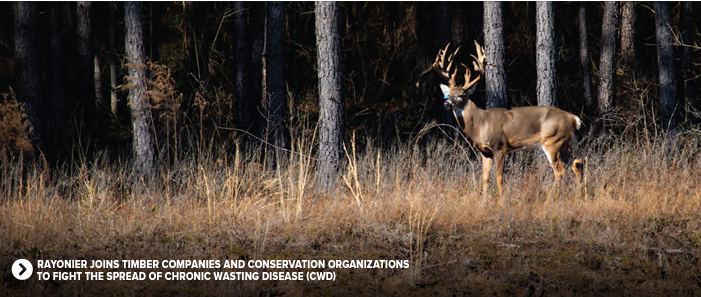
Rayonier forests are healthy and diverse ecosystems that we manage with a long-term mindset. We recognize the importance of maintaining biodiversity both for the health of our forests and the broader ecosystems in which they exist.
Rayonier is committed to protecting and closely monitoring biodiversity across our timberlands as we manage our working forests.
To this end, we follow programs and policies designed to protect the diverse natural capital embedded within our forests. We assess the biodiversity of our lands, minimize disturbances associated with our forestry activities, promote indigenous species, protect T&E species, safeguard ecologically sensitive areas, conduct prompt reforestation, and incorporate biodiversity considerations into our portfolio management activities. The following are more specific examples of the steps we take to proactively conserve and support the biodiversity that exists in and around our timberlands:
Assessing the biodiversity balance of our lands
Through our third-party certification processes, we maintain a formal biodiversity monitoring program. As part of this program, we regularly conduct assessments across our timberlands, which enable us to design and implement best practices to preserve specific habitats and to avoid certain forest management activities during particularly sensitive times. For example, we curtail our forest management activities during the nesting period in identified T&E habitats, including:
- In our U.S. South region, from September to May, we buffer active bald eagle nests by as much as 1,000 feet.
- In our U.S. Pacific Northwest region, from April to August, we primarily conduct activities between 2 hours after sunrise to 2 hours before sunset to reduce the risk of disturbance to nesting murrelets.
The detailed analyses we conduct, including classifying cover types by geography, also allow us to manage the quality and distribution of wildlife habitats, which is core to conserving biodiversity across our forests.
Promoting indigenous species and protecting threatened and endangered species
By maintaining a diversity of cover types, leaving buffers along riparian/streamside management zones, and following age class adjacency restrictions (both voluntary and mandated) for final harvests (referred to as green-up practices), we help indigenous plant and animal species continue to thrive as we conduct our forest management activities. Our species diversity further reflects our deliberate replanting and protection of various indigenous species in concert with green-up practices. Collectively, these efforts help our forests continue to provide abundant nesting habitat, food sources, and travel corridors for wildlife. We take particular care in protecting T&E species on our lands, including refraining from harvest activity as necessary and preserving select natural habitats with buffer areas.
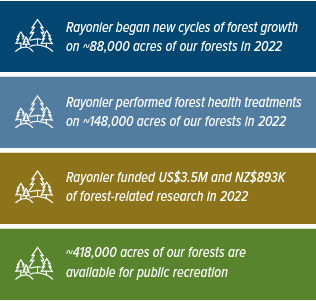
WHY POLLINATORS THRIVE IN WORKING FORESTS.
Safeguarding ecologically sensitive areas
Responsible stewardship of forestlands and the biodiversity within them is essential to protecting the ecosystems where we operate. Accordingly, we engage with state and federal agencies, as well as local stakeholders, including adjacent landowners and tribal authorities, to identify and protect ecologically sensitive areas. Specifically, in New Zealand, protection of highly ranked Significant Ecological Areas (SEAs) occurs through stringent best management practices designed to limit operational effects. The highest ranked areas have separate management plans and are inspected annually.
Incorporating biodiversity into portfolio management
In addition to taking necessary measures to protect biodiversity within our existing portfolio, we also incorporate a thorough review of ecosystem attributes as part of our due diligence on timberland acquisition opportunities. Specifically, we aim to identify any special sites, including known critical habitats for any T&E species and/or species of concern. If the timberlands being evaluated are ultimately incorporated into our portfolio, we then develop specific guidelines for the new properties to guide appropriate management moving forward.
THREATENED AND ENDANGERED SPECIES
Of the thousands of plants and animals in Rayonier’s forests, a few species are considered threatened or endangered, which we work actively to protect.
Our foresters and contractors are trained to be aware of and recognize protected T&E species and their habitats. We rely on mapping and database tools, as well as a working knowledge of our land, to determine where specific conservation practices are needed. In addition to our own efforts, we also participate in broader industry and conservation initiatives, such as population studies and surveys.
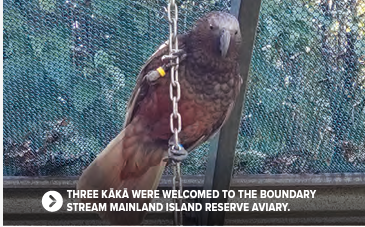
THREE KĀKĀ WERE WELCOMED TO THE BOUNDARY STREAM MAINLAND ISLAND RESERVE AVIARY.
In the U.S., we rely on state natural heritage programs, NatureServe, regular biodiversity assessments, and the routine field work of our foresters to locate potential occurrences of T&E species. In New Zealand, occurrences of Rare, Threatened, and Endangered Species (RTES) are recorded in our EMS database so that forest management plans can be adapted accordingly. In addition, certain areas designated as either Significant Ecological Areas (SEAs) or High Conservation Value Forests (HCVFs) require special procedures to ensure that they are protected. Through the use of these various tools, we have identified that approximately 50% of our forests have the potential of being a T&E species habitat.
Importantly, our forest management practices help reduce the risk of adverse impacts to the normal life cycle or habitat of T&E species. Such practices include surveying sites for species occurrences before conducting forest management activities, leaving buffers along riparian and natural habitat areas, or limiting harvest activities during certain times of the year.
Some T&E species are nomadic, which means they move from place to place and do not have fixed boundaries to their habitat. The modifications we make to our forest management practices for these species include hand planting versus machine planting, and/or adapting the timing of activity based on their cycle of movement.
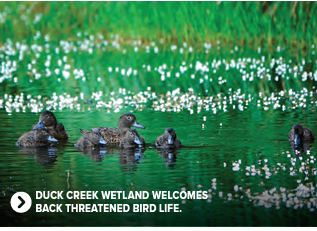
DUCK CREEK WETLAND WELCOMES BACK THREATENED BIRD LIFE.
SUCCESS STORY: THE GOPHER TORTOISE
The gopher tortoise plays a vital role as a keystone species whose burrow provides shelter to more than 300 other types of species.
Rayonier has its own spatial mapping system, which includes many layers of information, including a property’s soil type, topography, and notes regarding any protected species that have been identified on the property. Where gopher tortoises are identified, hand planting is conducted to minimize the use of heavy equipment needed.
When forests are ready for harvest, we also work with our logging contractors to protect gopher tortoises and their burrows. This may include site visits, pre-harvest meetings, flagging, and showing pictures to help identify what to look for.
Encouragingly, the U.S. Fish and Wildlife Service announced in 2022 that listing the gopher tortoise as a T&E species is no longer warranted for most of its range. Despite these changes in protected status, we continue to go above and beyond what is required to protect the species in all areas by maintaining the conditions they need to thrive through our forest management practices.
LEARN HOW FORESTERS BUILD PLANS AROUND PROTECTING GOPHER TORTOISES.
To learn more, view the full Rayonier 2022 Sustainability Report.
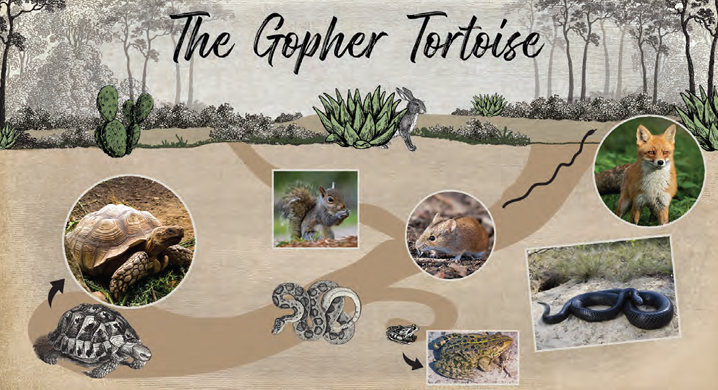

Rayonier
Rayonier
Rayonier (NYSE:RYN) is a leading timberland real estate investment trust with assets located in some of the most productive softwood timber growing regions in the United States and New Zealand. We own or lease under long-term agreements approximately 2.8 million acres of timberlands located in the U.S. South, U.S. Pacific Northwest and New Zealand. We are More than trees because we recognize that our 90+ years of success in the timberland industry comes from our people, an empowering culture and the courage to constantly challenge “the way it’s always been done.” Get to know us at www.rayonier.com.
More from Rayonier

